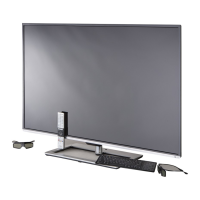
Do you have a question about the Toshiba 58L7350U and is the answer not in the manual?
Guidelines for safe television installation and usage to prevent accidents.
Recommendations for safely mounting televisions on walls or ceilings.
Advice on safely moving and placing older CRT televisions.
Further safety measures and warnings for handling the television.
Guidance on selecting an appropriate and safe location for the TV.
Instructions and precautions for mounting the TV using a wall bracket.
Important health advice and warnings related to viewing 3D content.
Instructions for safely cleaning, storing, and handling 3D glasses.
Explanation of symbols used to highlight safety cautions and their meanings.
Recommendations for selecting an appropriate and safe location for the TV.
Description of the buttons and their functions located on the back panel.
Explanation of the various input and output terminals on the back panel.
Introduction to different types of audio and video cables and their connectors.
Instructions for connecting a coaxial cable to the ANT/CABLE input.
Details on connecting standard AV cables for analog audio and composite video.
Explanation of how to use the IR blaster terminal for device control.
Steps for connecting a computer using analog RGB and PC audio cables.
Guide to connecting the TV to a computer using a crossover LAN cable.
How the TV remote can operate other connected devices via IR Blaster.
Step-by-step instructions for installing batteries in the remote control.
Steps for performing the initial setup, including language and basic settings.
How to use the remote control buttons to navigate and select menu options.
How to select the preferred language for the TV's menus and messages.
Explanation of the Quick Setup interface, progress window, and setup window.
Procedure to select the country of residence for TV setup.
How to specify the correct time zone for the TV's region.
Choosing between Store and Home modes for optimal TV location settings.
Instructions for setting up a network connection for internet access.
Detailed steps for configuring the IR Blaster for specific device types.
Instructions on navigating the TV's menu system using the remote control.
How to modify initial setup settings after the first setup.
Detailed configuration options for country, time zone, and other individual settings.
Guide to performing automatic channel scanning and storage.
Guide to setting up and using the TV's 3D viewing capabilities.
Explanation of Analog CC modes: Captions and Text display.
How to enable and configure V-Chip ratings to block content.
Procedure to download and use alternative rating systems for content blocking.
How to adjust horizontal/vertical position, clock phase, and sampling clocks for PC input.
Choosing from various picture sizes (Native, 4:3, Full, TheaterWide) for different content.
Explanation of different picture modes like AutoView, Dynamic, Standard, Movie, Game, PC.
Adjusting clarity levels automatically by enhancing picture edges.
Automatically adjusts contrast based on picture changes for better appearance.
How to reset expert picture settings to factory defaults.
Using a test pattern to aid in adjusting picture settings.
Enabling/disabling red, green, and blue components for color adjustment.
How to partially reduce or completely turn off the TV's sound.
How to select Stereo or SAP sound for analog broadcasts.
How to adjust the audio balance between the left and right speakers.
How to share media and access content across your home network using MediaShare.
Methods for setting up a wireless network connection (WPS, Assisted, Manual).
How to configure IP address settings automatically or manually.
How to access the on-screen context-sensitive TV manual.
Information about apps like Netflix and Hulu Plus for content discovery.
Steps for watching Netflix content, including player activation and Instant Queue.
Steps for connecting a camera, setting up network, and preparing for Skype use.
Configuring MediaShare to automatically start when a USB device is inserted.
How to navigate and select files or folders from a media server.
How to sort files from a media server by title, newness, or oldness.
How to view information about connected devices in MediaShare.
Steps to start, stop, and navigate movie playback.
How to resume movie playback from the last stopped position.
How to pause and resume movie playback.
Steps to start, stop, and navigate music playback.
How to pause and resume music playback.
How to use Skip Reverse/Forward buttons to find specific music files.
How to set repeat modes (Off, All, 1) for music playback.
How to search for photos in a grid format using thumbnail data.
How to view photos located in the selected directory.
How to enable or disable external control for devices.
How to access and configure the Home Control Profile settings.
How to download and use companion apps via Google Play or iTunes Store.
Basic steps to take before calling for service, including power cycling.
Resolving a black box issue by adjusting closed caption settings.
Troubleshooting steps when the TV becomes unresponsive to remote or panel controls.
Troubleshooting common picture issues like poor reception or incorrect input.
Steps to resolve issues preventing internet connection.
Troubleshooting steps for lack of network connectivity.
Troubleshooting automatic network setup failures.
Troubleshooting manual network setup failures.
Details on NTSC, ATSC, and Digital Cable standards supported.
Information on VHF, UHF, and Cable TV channel ranges.
List of VESA-DMT compliant signal formats accepted by the TV's PC IN.
Configuring the TV for different keyboard layouts, including U.S. International.
